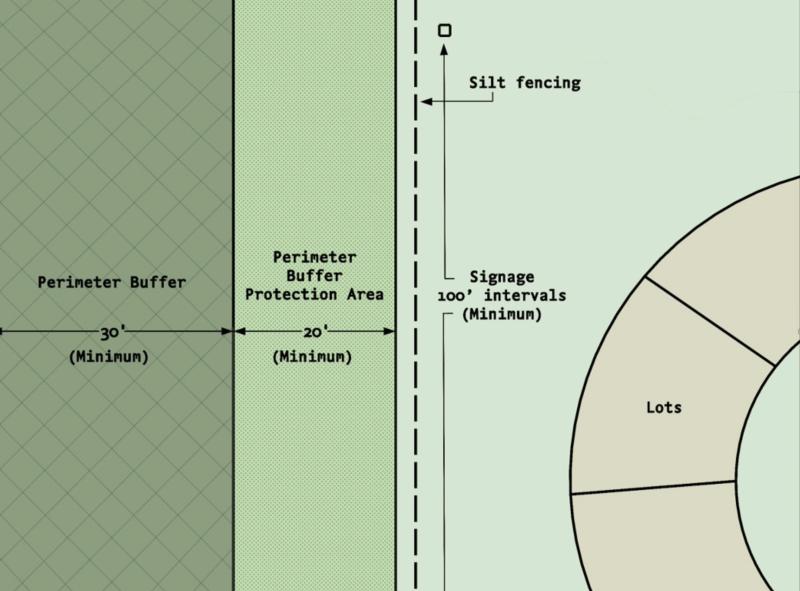Perimeter buffers still a work in progress?
The proposed ordinance to amend Sussex County’s perimeter buffer regulations may end up as a work still in progress, although public hearings have already been scheduled.
After detailed testimony for possible changes during the Sussex County Planning & Zoning Commission’s May 8 hearing, Chair Bob Wheatley said it’s not too late to make changes.
The commission voted to keep the record open for written comments for 10 days. Three people representing organizations who testified requested that action because they have more submissions to make. The record was closed on May 22.
Those who testified said the ordinance is a step in the right direction, but it needs additional provisions to strengthen it.
Sussex County Council has scheduled a public hearing on the ordinance at 1:30 p.m., Tuesday, June 11, in the county administration building, 2 The Circle.
The ordinance addresses perimeter buffer standards, buffers in woodlands and without woodlands, a landscape plan, maintenance, timing, bonding the guarantees, mitigation, and violations and penalties.
The key provisions in the ordinance include a new 20-foot protection area to protect perimeter buffers; a five-year look back to mitigate clear-cut perimeter buffer areas; perimeter buffers in place before building permits are issued; and a proposal that perimeter buffer and protection areas be delineated and protected before the notice to proceed is issued for site work to begin.
Under the new ordinance, perimeter buffers would be considered no-disturbance areas, and would be delineated by a silt fence and signage during construction.
Disturbance of the buffer area would trigger penalties and mitigation.
The protection zone
Assistant county attorney Vince Robertson said much of the new ordinance relates to comments from the public. “It’s what staff and county council hear all the time,” he said.
The key comments from the public, he said, include unnecessary tree removal in buffers, forest removal, timing for buffers to be in place and buffer width.
Each issue has been addressed.
If approved, in areas with existing woodlands, the ordinance would require a 30-foot buffer and a 20-foot protection zone.
Robertson said the protection zone would protect vital root systems to keep trees in the buffer from dying. All new plantings would have to be native species.
A provision that would allow the removal of trees in the protection zone was met with opposition from the Sussex Preservation Coalition and Sussex Alliance for Responsible Growth. Both organizations urged county officials to remove that section from the ordinance.
Commissioner Bruce Mears said there should be a provision that trees removed in the protection zone should not have their stumps ripped out, but ground out.
“Ripping out the roots negates the purpose of the protection area,” he said. “Do not rip out root systems of trees in protection areas.”
Builders want working group
Kitty Gillis, executive officer of the Homebuilders Association of Delaware with 375 members, asked the commission to create a working group to give all stakeholders a chance to provide input.
“The best way to make meaningful change is through consensus and compromise with all parties involved,” she said.
She requested the record be left open for the association to provide technical comments as well.
Robertson said a working group was not created but that stakeholders can make comments on the ordinance during public hearings. He said association members are welcome to testify at the Sussex County Council hearing in June.
“We will participate but would have appreciated a more collaborative approach,” Gillis said.
Commissioner Holly Wingate said more input from engineers would be meaningful.
Coalition recommendations
Steve Sinclair, a member of the Sussex Preservation Coalition’s Development Design Committee, spoke from his 42 years of experience working for the Vermont Department of Forests and Parks.
He said the county has the opportunity to really look at the natural resources in the county and plan for their conservation and use. “You’ve opened the door to preserve existing woodlands,” he added.
He said the required forest assessment in the perimeter buffer plan should be broadened to include a conservation plan, which is required in the resource buffer ordinance.
In addition, he said, a buffer protection area should be added to the resource buffer ordinance.
He suggested the buffer be expanded to at least 50 feet when woods are present to not only provide more screening but also create an area to mitigate flooding and provide a wildlife habitat.
Also, the mix of trees should be 60% deciduous and 40% evergreens.
Sinclair said he would provide the commission and council with a list of native trees for the area.
Rich Borrasso, representing Sussex Alliance for Responsible Growth, provided suggested changes throughout the ordinance.
Paramount, he said, is a requirement for a conservation plan to accompany the site plan. He said all other jurisdictions around Sussex County have that requirement.
Flooding, fallen trees
Jill Hicks, who had a buffer along her backyard property line removed, said she and her neighbors in Chapel Green have had to live with the consequences, including flooding and fallen trees. She is vice president of Sussex Preservation Coalition.
She said the ordinance would improve the quality of life for all Sussex County residents.
She said in early 2023, the property adjacent to her community was clear-cut up to property lines.
“Clear-cutting destroys habitats, destroys the balance of nature, and no one thrives in a sterile environment,” she said.
Wider buffers would create a wildlife corridor, she added.
For specifics regarding the ordinance, go to sussexcountyde.gov/sites/default/files/ordinances/Perimeter%20Buffer.pdf.
















































